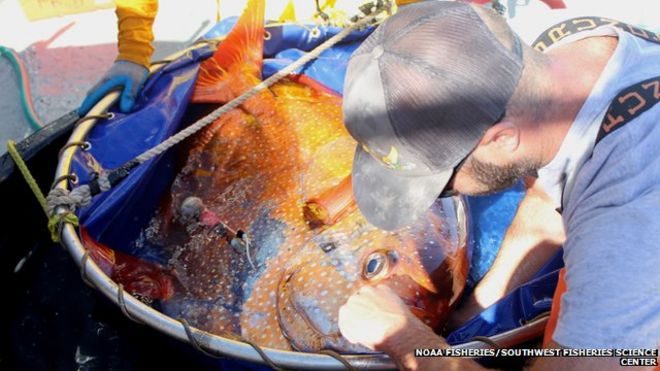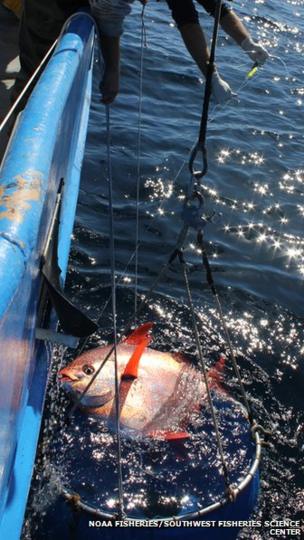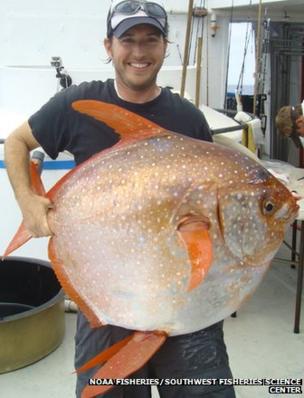- 15 May 2015
- From the section Science & Environment

The
large and colourful opah has become the first known "warm-blooded"
fish, as scientists discovered it can regulate the temperature of its
whole body.
The opah traps warmth from its flapping fins, which are well insulated by fat.It uses that heat to keep its heart, brain and other organs warm while it swims to depths of hundreds of metres.
Other fish like tuna can warm specific body parts, boosting performance at key times, but whole-body "endothermy" has not been observed in a fish before.
The research is published in the journal Science.
Mammals and birds are traditionally thought to be the planet's only warm-blooded animals, keeping their body temperature consistently warmer than the outside environment.
Fish and reptiles are almost entirely cold-blooded, or "ectothermic"; they are at the mercy of the environment for their warmth and largely get by on slower metabolic rates.

But deep-water fish such as the opah are usually relatively slow and sluggish, tending to ambush their prey instead of making chase.
This makes the new findings quite a surprise, according to the study's first author Nicholas Wegner.
Big fish
"Before this discovery I was under the impression this was a slow-moving fish, like most other fish in cold environments," said Dr Wegner, from the Southwest Fisheries Science Center run by the National Oceanic and Atmospheric Administration (NOAA) in the US."But because it can warm its body, it turns out to be a very active predator that chases down agile prey like squid and can migrate long distances."
Dr Wegner and his colleagues measured the temperature of different body parts in freshly caught fish. They also implanted thermometers while the animals dived beneath the waves.
They discovered that the opah's muscles were consistently about 5C warmer than the surrounding water, even when they descended between 50m and 300m under the surface, where the water is typically between 8C and 11C.

This might not seem like a huge advantage, but it requires some sophisticated thermal engineering - especially for a beast this size: the opah in the study weighed from 22kg to 68kg but the species has been known to reach 270kg.
Counter-current exchange
Instead of undulating its body like most fish, the opah propels itself by flapping its pectoral fins. These very active muscles are insulated from the water by a thick layer of fatty tissue, trapping the warmth.Crucially, when blood is pumped into the animal's gills to collect oxygen, heat loss is minimised by a dense, intertwined network of blood vessels called a rete mirabile.
At the surface of the gills, blood picks up oxygen and loses warmth. But as it passes back through the sponge-like rete mirabile (Latin for "wonderful net"), it regains some heat from the still-warm blood arriving from inside the fish's body.
The design was a bit like a car's radiator, Dr Wegner said.
"There has never been anything like this seen in a fish's gills before. This is a cool innovation by these animals that gives them a competitive edge.
"The concept of counter-current heat exchange was invented in fish long before we thought of it.

No comments:
Post a Comment